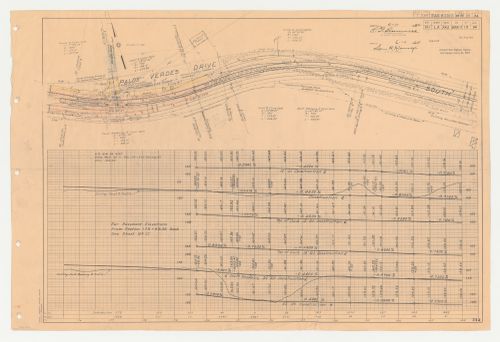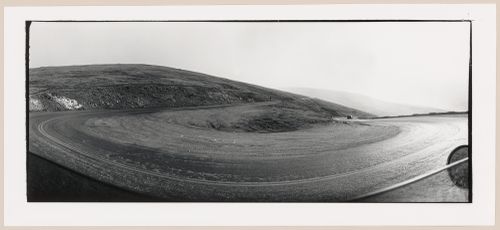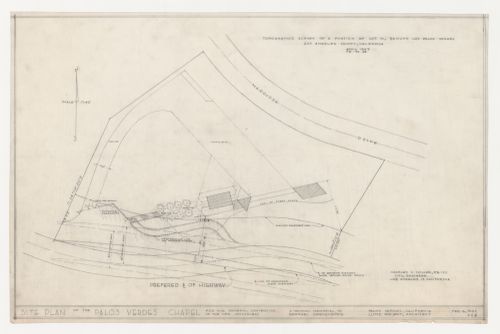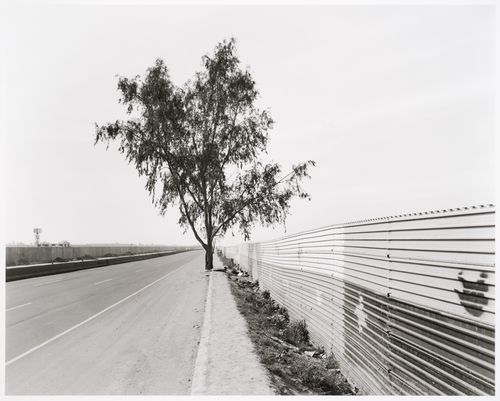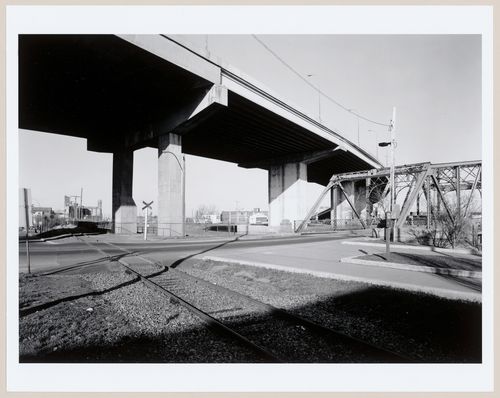ARCH400644
Description:
Signed Alessandro Poli-Superstudio.
1970-1971
Autostrada con sinusoide di energia [Highway with sine wave of energy] for Architettura Interplanetaria [Interplanetary Architecture]
Actions:
ARCH400644
Description:
Signed Alessandro Poli-Superstudio.
DR1987:0683
Description:
- This reprographic copy of a Los Angeles county road department site plan and graph shows the proposed changes to Palos Verdes Drive below Wayfarers' Chapel, Palos Verdes, California. A draughtsman, possibly Lloyd Wright, has coloured in part the reprographic copy to clarify the relationship between the chapel, its berm walls, and the proposed highway.
architecture, topographic
printed after 14 June 1954
Wayfarers' Chapel, Palos Verdes, California: Survey and curve data for the development of Palos Verdes Drive South into a highway
Actions:
DR1987:0683
Description:
- This reprographic copy of a Los Angeles county road department site plan and graph shows the proposed changes to Palos Verdes Drive below Wayfarers' Chapel, Palos Verdes, California. A draughtsman, possibly Lloyd Wright, has coloured in part the reprographic copy to clarify the relationship between the chapel, its berm walls, and the proposed highway.
architecture, topographic
PH1978:0151
architecture
1975
architecture
textual records
textual records
ARCH259680
1971-1972
textual records
1971-1972
DR1987:0692
Description:
- The survey information on drawing DR1987:0692 appears to be copied from an April 1949 survey by Charles C. Miller (probably DR1987:0679 or DR1987:0677).
architecture, topographic
16 February 1953
Wayfarers' Chapel, Palos Verdes, California: Topographic survey showing proposed and preferred locations for the development of Palos Verdes Drive South into a highway
Actions:
DR1987:0692
Description:
- The survey information on drawing DR1987:0692 appears to be copied from an April 1949 survey by Charles C. Miller (probably DR1987:0679 or DR1987:0677).
architecture, topographic
PH1997:0063
Description:
- The series "Running Fence 1997" focuses "on the first 14 miles of the border fence that separates the United States and Mexico, beginning at the Pacific Ocean and ending in the Otay Mountains.... [It] analyzes the "idea" of the border and explores its iconography, the border being a subject that is of extreme importance to the public as the world proceeds towards greater globalization. [Geoffrey] James has written of the project: "[The border fence] was built by the US Army Corps of Engineers in 1994, out of recycled metal landing strip - the most visible symbol of what is known as Operation Gatekeeper. Because the steel sheets are placed in the ground so that their ridges run horizontally, a man can hop over the fence with ease; and no Mexican child ever seems to be impeded from retrieving a soccer ball from US territory. The real barrier to illegal immigration from Mexico into the USA is less visible: hundreds of buried sensors linked to a central computer, nightscopes, helicopters and Border Patrol Agents in white Broncos."" (Evans).
architecture, engineering
1997
View along a highway leading to the airport in Tijuana, Baja California, Mexico, showing a partial view of the United States-Mexico border fence
Actions:
PH1997:0063
Description:
- The series "Running Fence 1997" focuses "on the first 14 miles of the border fence that separates the United States and Mexico, beginning at the Pacific Ocean and ending in the Otay Mountains.... [It] analyzes the "idea" of the border and explores its iconography, the border being a subject that is of extreme importance to the public as the world proceeds towards greater globalization. [Geoffrey] James has written of the project: "[The border fence] was built by the US Army Corps of Engineers in 1994, out of recycled metal landing strip - the most visible symbol of what is known as Operation Gatekeeper. Because the steel sheets are placed in the ground so that their ridges run horizontally, a man can hop over the fence with ease; and no Mexican child ever seems to be impeded from retrieving a soccer ball from US territory. The real barrier to illegal immigration from Mexico into the USA is less visible: hundreds of buried sensors linked to a central computer, nightscopes, helicopters and Border Patrol Agents in white Broncos."" (Evans).
architecture, engineering
PH1979:0441:131
1 March 1938
PH1986:1399
architecture
May 1985
architecture
photographs
Quantity:
18 photograph(s)
PH1998:0014:401-418
architecture
between 1926 and 1930
photographs
Quantity:
18 photograph(s)
between 1926 and 1930
architecture
![Autostrada con sinusoide di energia [Highway with sine wave of energy] for Architettura Interplanetaria [Interplanetary Architecture]](/img-collection/d8g368ABcKnUgIM7mykQZntwE3s=/500x511/472765.jpg)
